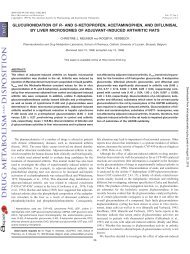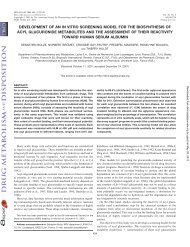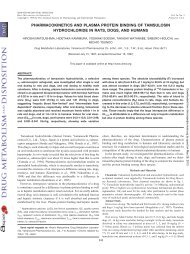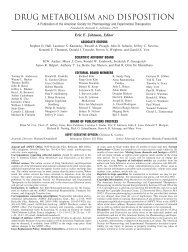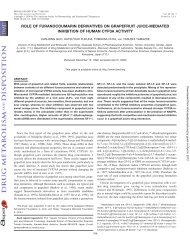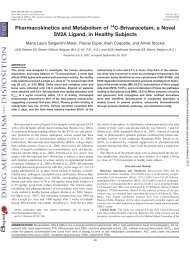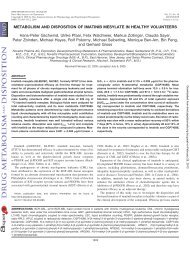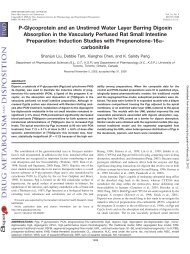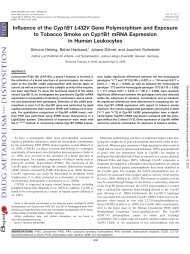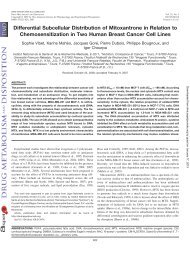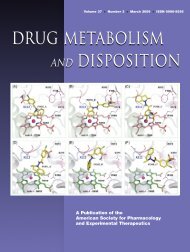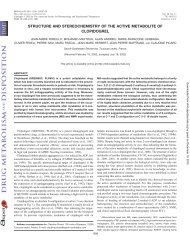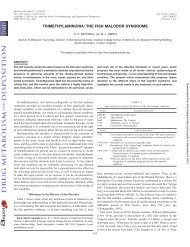In Vitro Glucuronidation of Thyroxine and Triiodothyronine by Liver ...
In Vitro Glucuronidation of Thyroxine and Triiodothyronine by Liver ...
In Vitro Glucuronidation of Thyroxine and Triiodothyronine by Liver ...
You also want an ePaper? Increase the reach of your titles
YUMPU automatically turns print PDFs into web optimized ePapers that Google loves.
2204 TONG ET AL.<br />
TABLE 1<br />
UGT is<strong>of</strong>orms used in the present study<br />
Is<strong>of</strong>orms Lot Number Activity<br />
pmol/min/mg<br />
UGT1A1 10 1000<br />
UGT1A3 11 150<br />
UGT1A4 2 1450<br />
UGT1A6 1 6970<br />
UGT1A8 15467 510<br />
UGT1A9 1 8740<br />
UGT1A10 23954 110<br />
UGT2B4 16905 700<br />
UGT2B7 11 1300<br />
UGT2B15 15468 2100<br />
UGT2B17 15397 2200<br />
UGT1A1 <strong>and</strong> UGT1A3 activity was measured as estradiol 3-glucuronidation. UGT1A4<br />
activity was determined as trifluoperazine glucuronidation. UGT2B17 activity was measured as<br />
eugenol glucuronidation. Activity <strong>of</strong> other UGT is<strong>of</strong>orms was determined as 7-hydroxy-4-<br />
trifluoromethylcoumarin glucuronidation.<br />
TABLE 2<br />
<strong>Liver</strong> microsomes used in the present study<br />
Species Sex Number <strong>of</strong> Subjects for Pool Cytochrome P450 Content<br />
nmol/mg protein<br />
Mouse Male 750 0.99<br />
Female 200 0.84<br />
Rat Male 191 0.88<br />
Female 25 0.62<br />
Dog Male 4 0.53<br />
Female 4 0.86<br />
Monkey Male 10 1.17<br />
Female 9 1.31<br />
Human Mix 50 0.43<br />
<strong>In</strong>cubations. <strong>In</strong>cubations with liver microsomes or recombinant human<br />
UGTs consisted <strong>of</strong> T4 or T3 (100 M), magnesium chloride (10 mM),<br />
microsomes (2 mg/ml) or supersomes (0.5 mg/ml), <strong>and</strong> UDP-glucuronic acid<br />
(UDPGA) (6 mM) in 0.5 ml <strong>of</strong> 0.1 M Tris-HCl buffer, pH 6.8 or 7.4.<br />
Alamethicin (50 g/mg protein) was mixed with liver microsomes for use in<br />
incubations. T4 or T3 in 5 l <strong>of</strong> methanol was added to the incubation tubes<br />
containing buffer, magnesium chloride solution, alamethicin, <strong>and</strong> microsomes<br />
or UGT is<strong>of</strong>orms. After mixing, the tubes were preincubated for 3 min in a<br />
shaking water bath at 37°C. The reactions were initiated <strong>by</strong> the addition <strong>of</strong> 30<br />
l <strong>of</strong> 100 mM UDPGA solution in water. Control incubations were conducted<br />
under the same conditions without UDPGA or microsomes. All the incubations<br />
were performed in duplicate. Reactions were stopped <strong>by</strong> the addition <strong>of</strong> 100 l<br />
<strong>of</strong> ice-cold methanol containing 5% trichloroacetic acid. Fex<strong>of</strong>enadine in 30 l<br />
<strong>of</strong> 10 M solution in methanol was added to each incubation as an internal<br />
st<strong>and</strong>ard, followed <strong>by</strong> the addition <strong>of</strong> 600 l <strong>of</strong> methanol. Samples were<br />
vortex-mixed. Denatured proteins were separated <strong>by</strong> centrifugation at 4300<br />
rpm <strong>and</strong> 4°C for 10 min in a Sorvall (Newton, CT) model T21 super centrifuge.<br />
An aliquot <strong>of</strong> the supernatant was analyzed <strong>by</strong> LC/MS.<br />
To evaluate the effect <strong>of</strong> pH on the formation <strong>of</strong> T4 glucuronides, T4 was<br />
incubated with human liver microsomes at pH 6.8 <strong>and</strong> 7.4 in the presence <strong>of</strong><br />
UDPGA at 37°C for 5, 10, 15, 20, 30, <strong>and</strong> 60 min. All the other incubations<br />
were conducted at pH 6.8 for 30 min.<br />
Hydrolysis <strong>of</strong> T4 <strong>and</strong> T3 Glucuronides. The sample prepared from incubations<br />
with human liver microsomes in the presence <strong>of</strong> UDPGA was dried<br />
under a nitrogen stream in a TurboVap LV evaporator (Zymark Corp., Hopkinton,<br />
MA). The residue was reconstituted in 1 ml <strong>of</strong> 0.1 M sodium acetate<br />
buffer, pH 5.0. Approximately 560 units <strong>of</strong> -glucuronidase in 100 l <strong>of</strong>0.1<br />
M sodium acetate buffer, pH 5.0, was added to 0.5 ml <strong>of</strong> the reconstituted<br />
solution, <strong>and</strong> the mixture was incubated at 37°C for 30 min with gentle<br />
shaking. The reaction was stopped <strong>by</strong> the addition <strong>of</strong> 1 ml <strong>of</strong> acetonitrile, <strong>and</strong><br />
the precipitated enzyme was removed <strong>by</strong> centrifugation. The supernatant was<br />
evaporated under nitrogen to remove acetonitrile. An aliquot <strong>of</strong> the aqueous<br />
residue was analyzed <strong>by</strong> HPLC. A control incubation was prepared under the<br />
same conditions but without -glucuronidase.<br />
For alkaline hydrolysis, the sample was adjusted with 2N sodium hydroxide<br />
to about pH 11 <strong>and</strong> incubated at 37°C for 60 min. After adjustment with acetic<br />
acid to about pH 5, an aliquot was analyzed <strong>by</strong> HPLC. A control incubation<br />
was conducted at pH 6.8. All the samples were analyzed <strong>by</strong> LC/MS to monitor<br />
the glucuronides <strong>and</strong> the internal st<strong>and</strong>ard.<br />
LC/MS. A Waters model 2690 HPLC system (Waters Corp., Milford, MA)<br />
with a built-in autosampler <strong>and</strong> a diode array UV detector was used for<br />
analysis. The UV detector was set to monitor 200 to 400 nm. Separations were<br />
accomplished on a Luna C18(2) column (150 2.0 mm, 5 m) (Phenomenex,<br />
Torrance, CA). The sample chamber in the autosampler was maintained at 4°C,<br />
whereas the column was at ambient temperature <strong>of</strong> about 20°C. The mobile<br />
phase consisted <strong>of</strong> 0.1% trifluoroacetic acid in water (A) <strong>and</strong> 0.1% trifluoroacetic<br />
acid in acetonitrile (B) <strong>and</strong> was delivered at 0.2 ml/min. The mobile<br />
phase B linearly increased from 25% to 65% over the first 5 min, to 85% over<br />
10 min, <strong>and</strong> then to 95% over 5 min. The first 7 min <strong>of</strong> flow was diverted away<br />
from the mass spectrometer.<br />
The HPLC system was coupled to a Micromass Quattro Ultima triple<br />
quadrupole mass spectrometer (Micromass, <strong>In</strong>c., Beverly, MA), which was<br />
equipped with an electrospray ionization interface <strong>and</strong> operated in the positive<br />
ionization mode. The capillary <strong>and</strong> cone voltages were set at 4000 <strong>and</strong> 20 V,<br />
respectively. The cone <strong>and</strong> the desolvation gas flows were 100 <strong>and</strong> 1100 l/h,<br />
respectively. The source block <strong>and</strong> the desolvation gas temperatures were set<br />
at 105 <strong>and</strong> 200°C, respectively. Mass resolution for multiple reaction monitoring<br />
was 15 for MS1 <strong>and</strong> MS2. The scan mode used selected reaction<br />
monitoring with ion transitions <strong>of</strong> m/z 953.5 to 777.5 for T4 glucuronides, m/z<br />
827.7 to 651.7 for T3 glucuronides, <strong>and</strong> m/z 502 to 466 for fex<strong>of</strong>enadine at<br />
collision energy <strong>of</strong> 25 eV. Micromass MassLynx s<strong>of</strong>tware (version 4.0) was<br />
used for collection <strong>and</strong> analysis <strong>of</strong> LC/MS data. The peak area ratio <strong>of</strong><br />
glucuronides to the internal st<strong>and</strong>ard was used for comparison <strong>of</strong> enzyme<br />
activities.<br />
To evaluate the limit <strong>of</strong> detection <strong>and</strong> linearity <strong>of</strong> MS response, T4 was<br />
incubated with human liver microsomes in the presence <strong>of</strong> a mixture <strong>of</strong><br />
[ 14 C]UDPGA <strong>and</strong> nonlabeled UDPGA (1:5) as described under <strong>In</strong>cubations.<br />
The phenolic glucuronide was isolated <strong>by</strong> HPLC using the same conditions<br />
described above, except that a 250 4.6-mm column was used, <strong>and</strong> the mobile<br />
phase was delivered at 0.6 ml/min. The isolated fractions were concentrated<br />
under nitrogen <strong>and</strong> reconstituted with the control incubation mixture. An<br />
aliquot <strong>of</strong> the supernatant was analyzed <strong>by</strong> LC/MS after protein precipitation.<br />
The amount <strong>of</strong> T4 glucuronide was calculated <strong>by</strong> the specific radioactivity <strong>of</strong><br />
[ 14 C]UDPGA in the incubation <strong>and</strong> the radioactivity in the isolated fractions<br />
after concentration.<br />
NMR Analysis <strong>of</strong> T4 Phenolic Glucuronide. T4 phenolic glucuronide was<br />
isolated as described in the above section from incubations <strong>of</strong> T4 with human<br />
liver microsomes in the presence <strong>of</strong> nonradiolabeled UDPGA. The isolated<br />
fractions were dried under a nitrogen stream <strong>and</strong> reconstituted in approximately<br />
160 l <strong>of</strong> deuterated methanol (CD 3 OD) <strong>and</strong> transferred to a 3-mm o.d.<br />
NMR tube. For the purpose <strong>of</strong> comparison, a saturated T4 solution was also<br />
prepared in CD 3 OD. Data were collected on Varian <strong>In</strong>ova 500 MHz <strong>and</strong><br />
Bruker Avance 600 MHz spectrometers, each equipped with a 3-mm<br />
z-gradient indirect detection probe. One-dimensional proton 1 H NMR data <strong>and</strong><br />
two-dimensional gradient selected correlation spectroscopy, total correlation<br />
spectroscopy, heteronuclear 1 H- 13 C gradient heteronuclear single quanta cor-<br />
FIG. 1. Formation <strong>of</strong> the phenolic glucuronide <strong>and</strong> acyl glucuronide <strong>of</strong> T4 (r I) <strong>and</strong> T3 (r H).



